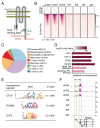Nuclear VANGL2 Inhibits Lactogenic Differentiation
- PMID: 38334614
- PMCID: PMC10854645
- DOI: 10.3390/cells13030222
Nuclear VANGL2 Inhibits Lactogenic Differentiation
Abstract
Planar cell polarity (PCP) proteins coordinate tissue morphogenesis by governing cell patterning and polarity. Asymmetrically localized on the plasma membrane of cells, transmembrane PCP proteins are trafficked by endocytosis, suggesting they may have intracellular functions that are dependent or independent of their extracellular role, but whether these functions extend to transcriptional control remains unknown. Here, we show the nuclear localization of transmembrane, PCP protein, VANGL2, in the HCC1569 breast cancer cell line, and in undifferentiated, but not differentiated, HC11 cells that serve as a model for mammary lactogenic differentiation. The loss of Vangl2 function results in upregulation of pathways related to STAT5 signaling. We identify DNA binding sites and a nuclear localization signal in VANGL2, and use CUT&RUN to demonstrate recruitment of VANGL2 to specific DNA binding motifs, including one in the Stat5a promoter. Knockdown (KD) of Vangl2 in HC11 cells and primary mammary organoids results in upregulation of Stat5a, Ccnd1 and Csn2, larger acini and organoids, and precocious differentiation; phenotypes are rescued by overexpression of Vangl2, but not Vangl2ΔNLS. Together, these results advance a paradigm whereby PCP proteins coordinate tissue morphogenesis by keeping transcriptional programs governing differentiation in check.
Keywords: VANGL2; mammary gland; nuclear localization.
Conflict of interest statement
The authors have no conflicts of interest.
Figures





Update of
-
Nuclear VANGL2 Inhibits Lactogenic Differentiation.bioRxiv [Preprint]. 2023 Dec 8:2023.12.07.570706. doi: 10.1101/2023.12.07.570706. bioRxiv. 2023. Update in: Cells. 2024 Jan 25;13(3):222. doi: 10.3390/cells13030222. PMID: 38106173 Free PMC article. Updated. Preprint.
References
-
- Puvirajesinghe T.M., Bertucci F., Jain A., Scerbo P., Belotti E., Audebert S., Sebbagh M., Lopez M., Brech A., Finetti P., et al. Identification of p62/SQSTM1 as a component of non-canonical Wnt VANGL2-JNK signalling in breast cancer. Nat. Commun. 2016;7:10318. doi: 10.1038/ncomms10318. - DOI - PMC - PubMed
MeSH terms
Substances
Grants and funding
LinkOut - more resources
Full Text Sources
Research Materials
Miscellaneous

